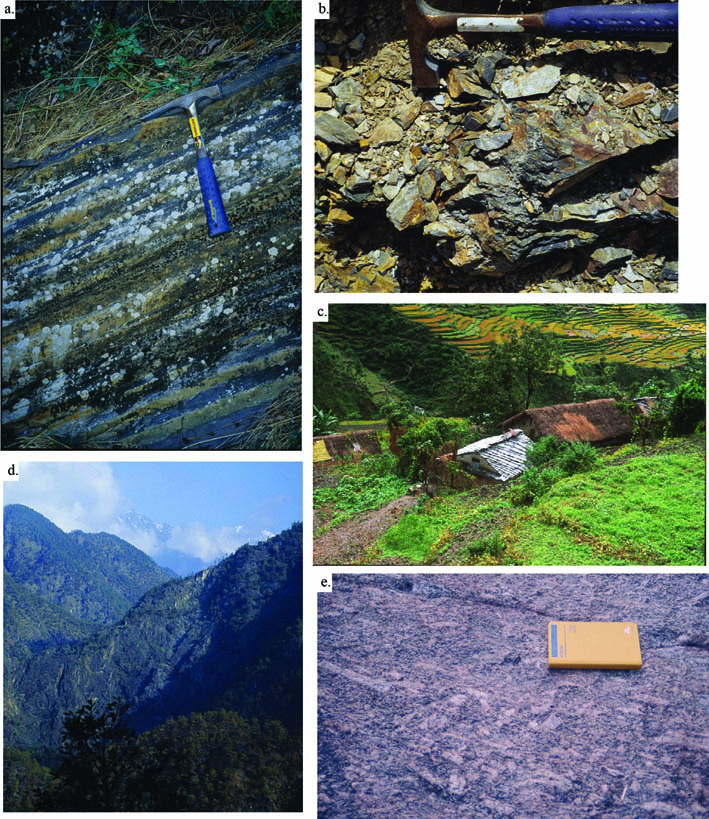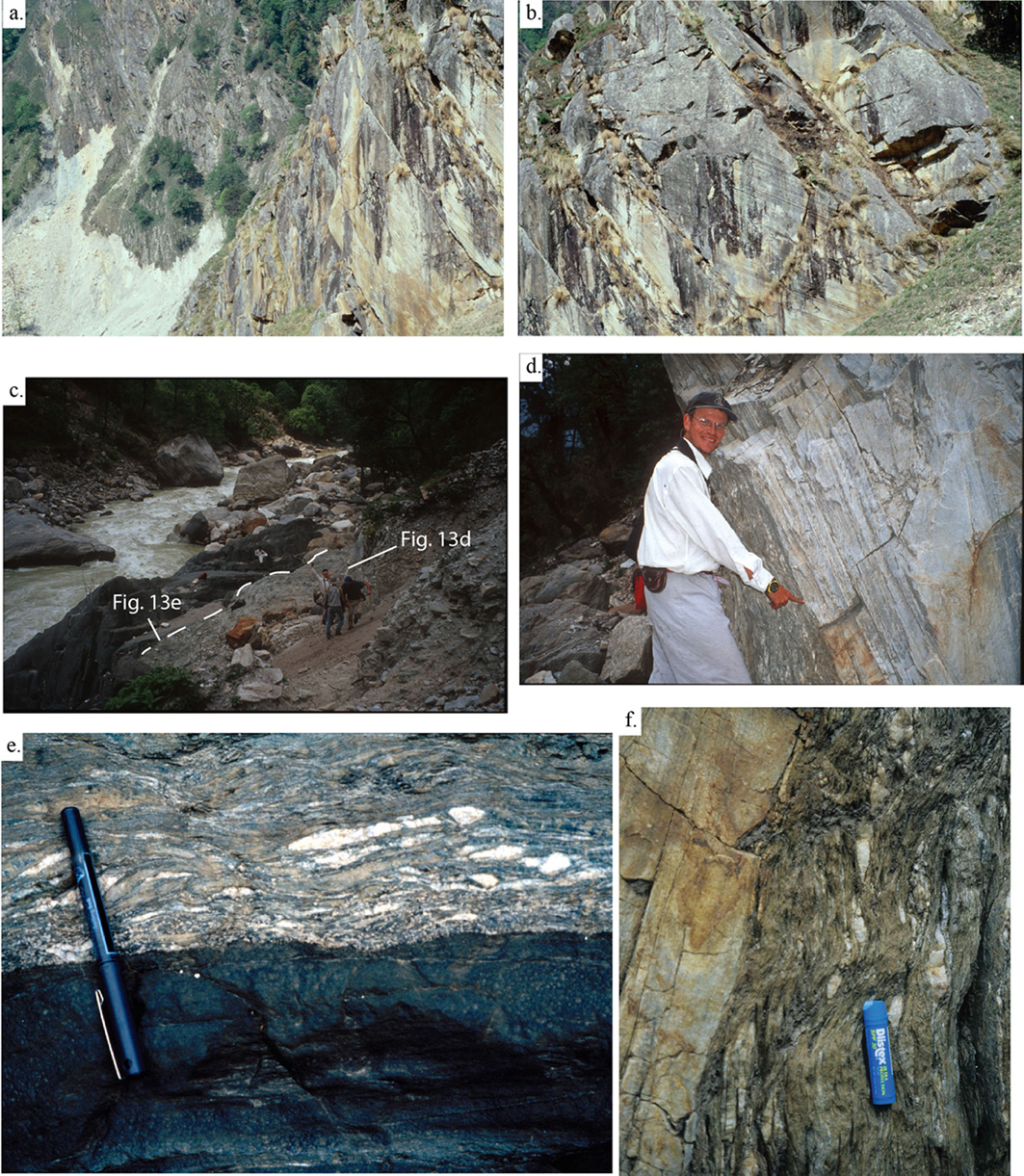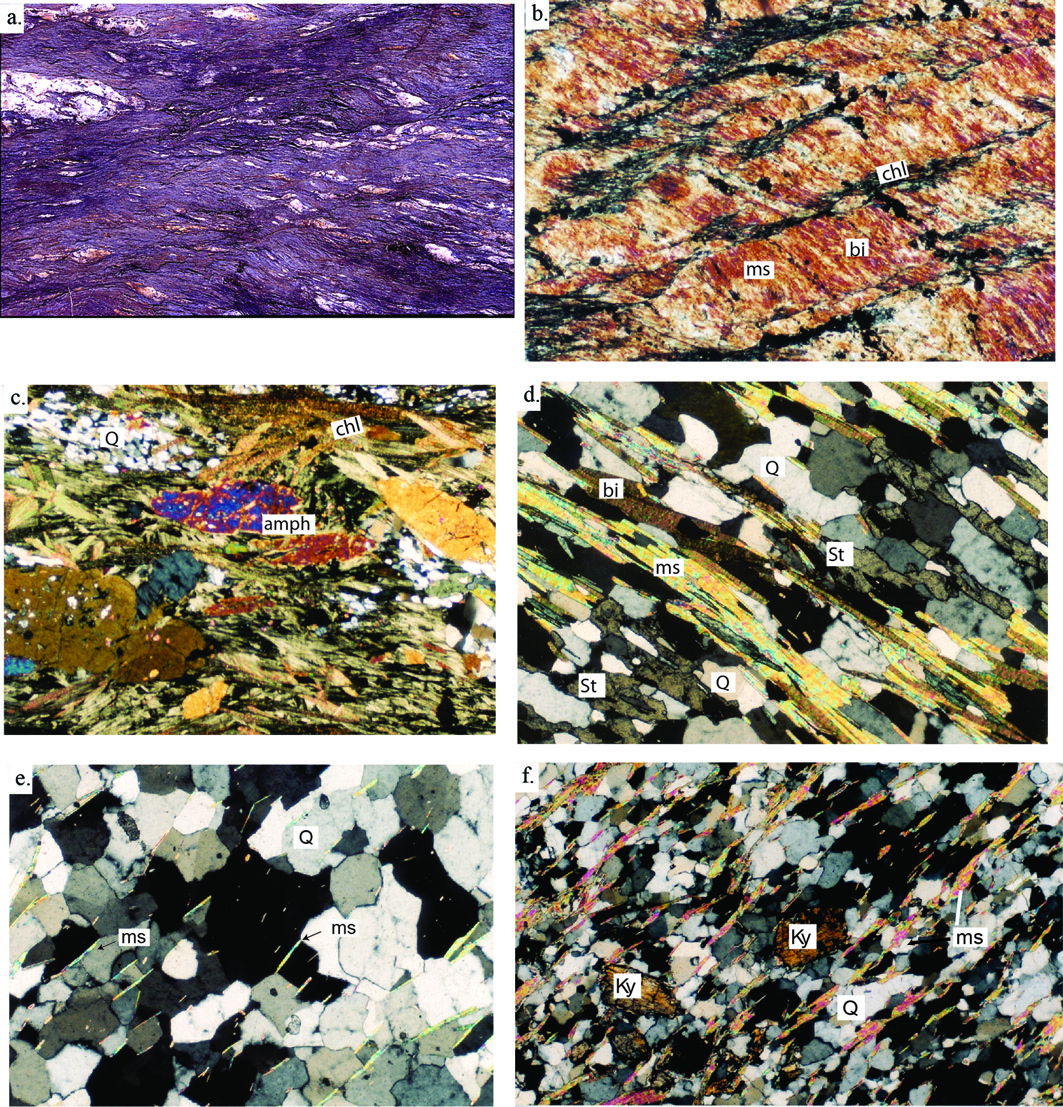DAY 9. Northern Lesser Himalayan Duplex
On the northeast side of the fold in the window you will pass back into the Galyang Formation (Fig. 12b), which has been thrust southward on top of the Dumri and Bhainskati formations. At this location, the Galyang Formation slate has small-scale folds; similar structures are present in the underlying Dumri and Bhainskati formations. The last of the Galyang Formation exposures are just south of Talkot (N29º36’23.5”; E81º16’40.3”). From the Galyang Formation, you will cross another major thrust fault back into the Ranimata Formation (Fig. 12c). At Talkot, the trail and Seti River turn northward and the topography steepens (Fig. 12d). As you are traversing through this thrust sheet you will pass into a Proterozoic augen gneiss (Fig. 12e). Along the trail, exposures show that the contact between the Ranimata Formation and the augen gneiss is intrusive because there are veins of the augen gneiss intruded into the phyllite (N29º40’19.8”; E81º19’31.8” 2105±147 m).
Figure 12. Bhanskati, Galyang, Ranimata and Kushma Formations and Proterozoic gneiss

a) Bhanskati Formation of the Foreland Basin sequence. Black shale interbedded with light gray shale. 0.25 m hammer for scale (N29°35’ 56.1”; E81°14’ 52.4”; 1324±125 m). (b) Thin fissile brown phyllite of the Galyang Formation. 0.25 m hammer for scale (N29°36’ 18.8”; E81°15’ 59.6”; 4755±230’). (c) Roof tiles composed of the Ranimata Formation in the village of Talkot. (d) Photo is from the location in Figure 12e looking toward the north up the Seti River. Ridges of rock are in the Kushma Formation. (e) Proterozoic augen gneiss with S-C fabric. Field notebook is 15 cm long (N29°40’ 19.8”; E81°19’ 31.8”; 6907±492’).
Proterozoic Augen Gneiss
The augen gneiss is a medium-grained, foliated, L-S tectonite, and is present in Paleoproterozoic rocks across Nepal (LeFort, 1975; Pêcher & Le Fort, 1977; Stöcklin, 1980; Phaplu augen gneiss of Maruo & Kizaki, 1981). Many workers have assumed that this augen gneiss is Indian basement and place a fault at the base of the gneiss (MCT-1; Arita, 1983). However, the Proterozoic augen gneiss intrudes the Ranimata Formation and yields a ca. 1.83 Ga U-Pb zircon age (DeCelles et al., 2000; Martin et al., 2011). Kohn et al. (2010) recalculated this age from DeCelles et al. (2000) to be 1.84±0.03 Ga. This age provides a minimum age boundary for the Ranimata Formation.
In far-western Nepal, thickness of the Proterozoic augen gneiss varies between 500 m and 10 km. Map patterns and foliations are concordant with those of the surrounding Ranimata Formation suggesting that the intrusions are sills. The edges of the intrusive bodies are mylonitic with top-to-the-south sense of shear indicators (Schelling, 1992), but internal parts of augen gneiss bodies are generally only slightly deformed. To the northeast of Chainpur, the Proterozoic augen gneiss is intruded by dioritic bodies.
Ramgarh-Munsiari thrust sheet and imbricates
Figure 12d is taken from the Proterozoic augen gneiss looking north up the Seti River. The ridges are supported by the quartzite carried on multiple thrust sheets in the LH duplex. The trail will descend along a side creek to the east and then ascend. As it ascends, the trail cuts through the Kushma Formation quartzite. In these exposures, there are garnets in hand sample, kyanite in thin section, and trough cross bedding in the outcrop. Balancing the cross section (Fig. 3b), helped to determine that the RMT doubles the thickness of the Kushma Formation in this location. The camping site is located at the base of the Kushma cliff near Ghat Khola (N29º43’14.7”; E81º20’49.1”; 2168±70 m). On the descent, you will pass into the Ranimata Formation.
Kushma Formation
Detrital zircons suggest that the Kushma Formation is ~1.85 Ga (DeCelles et al., 2000). The Kushma Formation is a structurally competent, medium- to coarse-grained, white to green orthoquartzite with local muscovite-rich partings (Figs. 13a, 13b). Occasional quartz pebble conglomerate layers are present. Oscillatory current ripples, plane-parallel stratification, and planar and trough cross-stratification (Fig. 13b) are common sedimentary structures in the Kushma Formation. Mineral compositions include quartz + muscovite ± garnet ± kyanite. Generally, the Kushma Formation is thickly bedded and tabular, with zones of thinly bedded quartzite and green phyllite in its upper part. The Kushma Formation is 800—1000 m thick in far-western Nepal and crops out in high cliffs and rugged mountains (3-5 km elevation) south of the MCT. Meso-scale folds are usually absent except in the vicinity of major faults. The basal contact of the Kushma Formation is everywhere a thrust fault and the upper contact is transitional with the overlying Ranimata Formation. The Kushma Formation is strongly recrystallized near the MCT (Pearson, 2002) (Fig. 14e).
Figure 13. Kushma Formation and RMT

a) Kushma Formation quartzite showing clean white quartzite beds, courtesy of Ofori Pearson. (b) Kushma Formation cross bedding, courtesy of Ofori Pearson. (c) Discovery of the RMT with joyous hand-waving Ofori Pearson for scale. (Figures 13c-f are at location N29°45’33.0; E81°17’28.2”; 6970’). (d) The RMT with Ofori Pearson for scale, location shown in Fig. 13c. (e) The Ranimata Formation in contact between the phyllite and mafic intrusives showing a chilled margin. Location shown in Fig. 13c. (f) The RMT at a different nearby outcrop showing the Kushma Formation quartzite in thrust contact with the footwall Ranimata Formation phyllite/schist.
Figure 14. Ranimata and Kushma Formations

a) S-C fabric in the Ranimata Formation below the RMT south of Dhuli. (b) Crenulation cleavage in the Ranimata Formation; muscovite (ms), biotite (bi), chlorite (chl), quartz (Q). Field of view is ~4.5 mm. (c) Ranimata Formation mafic intrusive rock, containing amphibole (amph), chlorite (chl), and quartz (Q). (d) Staurolite (St) porphyroblasts in the Ranimata Formation. (e) Recrystallized coarse-grained quartzite in the Kushma Formation. (f) Strained fine-grained quartzite in the Kushma Formation with porphyroblasts of kyanite (Ky). Field of view for all photomicrographs is ~4.5 mm on the vertical.
In far-western Nepal, the northernmost exposures of LH rocks in the LH duplex indicate peak temperatures of 500-550ºC, based on Raman Spectroscopy of Carbonaceous Material (RSCM) (Bollinger et al., 2004). Beyssac et al. (2004) reported that the RSCM temperatures in LH rock along the Nepal/India border decrease gradually from 540ºC in the footwall of the MCT to 330ºC in the middle of the LH duplex. This southward decrease in temperature away from the MCT indicates that the magnitude of overburden that buried these samples also decreases southward. In addition, the RSCM data indicate that the northernmost LH rocks reached the temperatures necessary to reset 40Ar/39Ar muscovite ages. Robinson et al. (2006) reported an 40Ar/39Ar muscovite cooling age from the Ranimata Formation carried by the RMT sheet (SR123; N29º45’11.8; E81º16’6.6”; 2128 m) of 17-7 Ma (Table 2), and an 40Ar/39Ar muscovite cooling and isochron age of 12.5-12 Ma (SR103a) from the Ranimata Formation in the northern part of the LH duplex (Table 2).
Camping this night at Ghat Khola (Camp 9 on Fig. 2)
